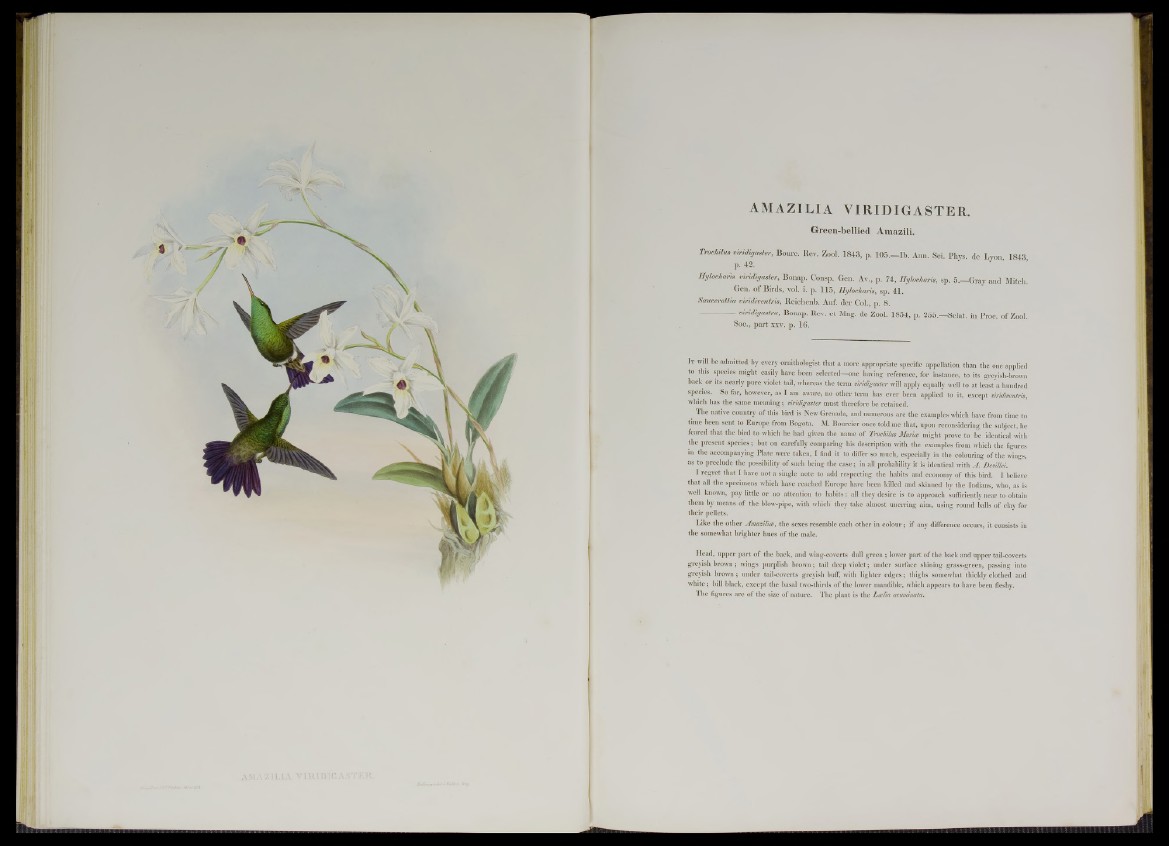
AMAZILIA VIRIDIGASTER.
Green-bellied Amazili.
Trochilus viridigaster, Bourc. Rev. Zool. 1843, p. 105.— Ib. Ann. Sci. Phys. de Lyon 1843
p . 42.
B y lo ch am viridigaster, Bonap. Consp. Gen. At., p. 74, Bylocharis, sp. 5.—Gray and Mitch.
Gen. o f Birds, vol. i. p. 115, Eylocliaris, sp. 41.
Saucerottm viridiventris, Reichenb. Auf. der Col., p. 8.
— mridigastra, Bonap. Rev. e t Mag. de Zool. 1854, p. 255.— Sclat. in Proc. o f Zool.
Soc., p a rt xxv. p. 16.
It will be admitted by every ornithologist that a more appropriate specific appellation than the one applied
to this species might easily have been selected—one having reference, for instance, to its greyisli-brown
back or its nearly pure violet tail, whereas the term viridigaster will apply equally well to at least a hundred
species. So far, however, as I am aware, no other term has ever been applied to it, except viridiventris,
which has the same meaning; viridigaster must therefore be retained.
The native country of this bird is New Grenada, and numerous are the examples which have from time to
time been sent to Europe from Bogota. M. Bourcier once told me that, upon reconsidering the subject, he
feared that the bird to which he had given the name of Trochilus Maria might prove to be identical with
the present species; but on carefully comparing his description with the examples from which the figures
in the accompanying Plate were taken, I find it to differ so much, especially in the colouring of the wings,
as to preclude the possibility of such being the case; in all probability it is identical with A . Devillei.
I regret that I have not a single note to add respecting the habits and economy of this bird. I believe
that all the specimens which have reached Europe have been killed and skinned by the Indians, who, as is
well known, pay little or no attention to habits: all they desire is to approach sufficiently near to obtain
them by means of the blow-pipe, with which they take almost unerring aim, using round balls of clay for
their pellets.
Like the other Amazilice, the sexes resemble each other in colour; if any difference occurs, it consists in
the somewhat brighter hues of the male.
Head, upper part of the back, and wing-coverts dull green ; lower part of the back and upper tail-coverts
greyish brown; wings purplish brown; tail deep violet; under surface shining grass-green, passing into
greyish brown; under tail-coverts greyish buff, with lighter edges; thighs somewhat thickly clothed and
white; hill black, except the basal two-thirds of the lower mandible, which appears to have been fleshy.
The figures are of the size of nature. The plant is the Lcelia acuminata.